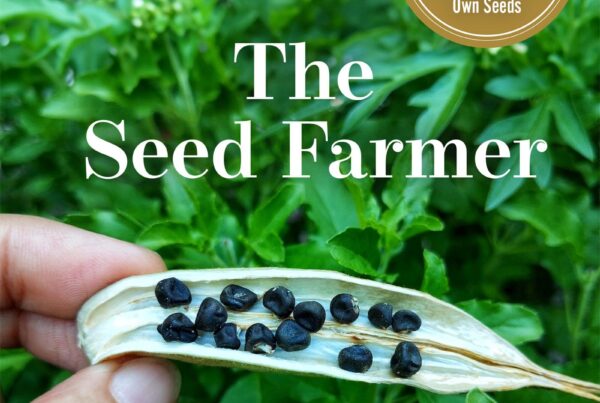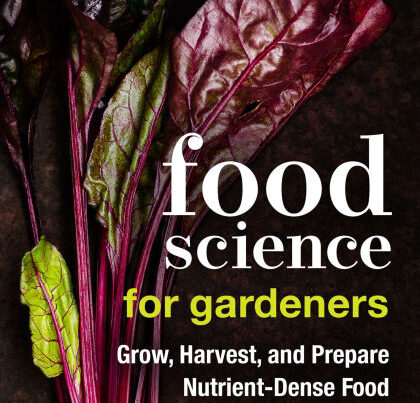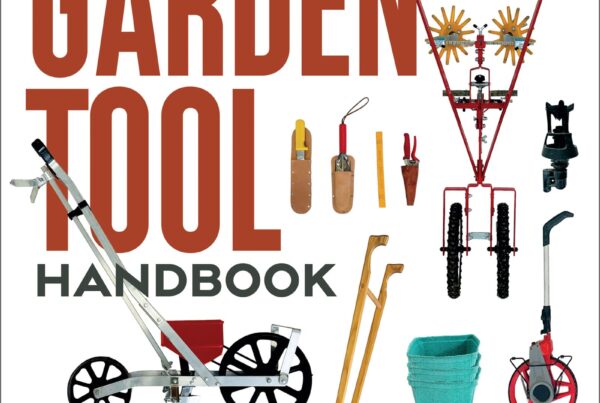Book Review
The Seed Detective: Uncovering the Secret Histories of Remarkable Vegetables, Adam Alexander, Chelsea Green Publishing, 2022. 306 pages, $22.00.
Book Review by Pam Dawling, Author of Sustainable Market Farming: Intensive Vegetable Production on a Few Acres, and The Year-Round Hoophouse: Polytunnels for All Seasons and All Climates
Adam Alexander is a seed collector, seed conserver, seed distributor, gardener, and a fascinating writer. He set out to find the origin of many vegetables, dividing the book into crops arriving from east of his home in Wales, and crops arriving from the west. He is a researcher and traveler, gourmet foodie, and one-time market gardener who couldn’t sell red Brussels sprouts.
He has joyfully searched out and found many rare, sometimes endangered (and in at least one case, the last known) seeds. He grows out the seeds he is given, and returns some seed to the person who lent them to him. He is very respectful of people’s cultures, and won’t grow for financial gain any crop that has been entrusted to him. He has enchanting stories of his efforts to seek out the seeds he’d heard about, in vegetable markets and dusty cupboard corners.
He has a website, podcast, videos and seed list at https://theseeddetective.co.uk/ He has 499 varieties of vegetable seeds, and grows out around 70 of them each year, in his garden, which includes a polytunnel (hoophouse). For some of the crops, he works with the Heritage Seed Library in the UK. If you live in the UK, he will send you a packet of seeds for a donation of £1 plus £1.50 for postage. As I write this, in August, many varieties are out of stock. Seeds are maturing, be patient.
Adam explains why garlic was fed every day to Egyptian pyramid builders; how chilies from 6000 BCE were found in a Mexican cave; why there is so much confusion between squash, pumpkins, zucchini/courgettes and marrows; and why giant Christmas lima beans are popular in northern Myanmar.
Agricultural history and archeology contain intriguing stories, and Adam tells these tales with humor, passion, insight. Maritime history is included, so we understand why and how certain beans were valued as storable foods for the crew on long journeys, incidentally spreading the leftover beans in the land of their arrival.
From the east, Britain received various peas, fava (broad) beans, carrots before they were orange, leeks (no, they really are not native to Britain!), asparagus, lettuce, garlic and many brassicas with unfamiliar names. From the west came tomatoes, green (“French”) beans and their dried offspring, maize in its many types, lima beans, runner beans, chili peppers and the whole squash-pumpkin hyphenated extended family (except Lagenaria siceraria gourds).
This book includes global histories and geography, and starts from a British perspective in the demarcation of East and West. There is a mistaken reference to Thomas Jefferson’s New York State home of Monticello. Elsewhere, the author correctly locates Monticello in Virginia. Jefferson did rent a house in New York City while Secretary of State. “The only person who never makes a mistake is the person who never does anything!” (Theodore Roosevelt)
Adam truly wants us all to enjoy healthy food – this is far from dry research. Vegetables have been industrialized to maximize profit for some at the expense of those who toil in the fields. Crops have, in some cases, been patented. Their flavors and nutrients have been ignored. We can change this. We can rebuild biodiversity, bring back flavor and the enjoyment of eating vegetables! We can put plants “at the heart of good cuisines and health” as Tim Lang says in his Foreword.
In his previous life, Adam was a film and television producer, used to travelling widely. In his introduction, Adam tells of an evening when his film crew took over the kitchen of their hotel in Donetsk, because they were hungry and the kitchen staff were on strike in protest at the foreign film crew staying there. Adam was able to shop well, with a very favorable currency exchange rate. He found some tennis-ball sized sweet red peppers with a fiery heart. They enjoyed their dinner and Adam was able to take some seeds home. This started his seed detective journey. From then on, he used every opportunity to seek out farmers’ markets and ask the stall-holders about local varieties. He started to build a seed library, because he realized some of the seeds were in danger of going extinct.
His began to wonder about how those crops had arrived in that country, and what was their place of origin. There were eight Centres of Diversity identified by Nikolai Vavilov, who created the world’s biggest seed bank, the All-Russian Research Institute. Since then, additional Centres of Diversity have been recognized, such as in Australasia and Africa. In this book, we meet plants from just three of those Centres: the Fertile Crescent in the Middle east, Mesoamerica, and the northern parts of Peru, Ecuador and Bolivia. These hilly or mountainous, tropical or sub-tropical regions are now associated with drought, but at the time of domestication 12,000 years ago, were rich in natural resources including rainfall. Our current day vegetables are the result of Neolithic farmers selecting plants to save for seed.
According to the historian Mary Beard, the Romans were the first society to export their food culture as part of their brand, Cabbages, kale, cauliflower, broccoli, asparagus, lettuce and leeks all travelled with the legions, as familiar comfort food to fuel them for the invasions. Sophisticated Arabic irrigation systems enabled Moors invading Spain in the eighth century CE, to plant saffron, apricots, artichokes, carob, eggplants, grapefruits, carrots, coriander and rice, which all became basic ingredients of Spanish cuisine. Vegetables have been travelling the globe for a long time! Here I cannot include much of the particular seed tales, so read the book!
Adam’s first tale is of a local pea variety in Laos. Through an interpreter, he asked a market stall-holder about some pea seeds she had for sale. To his every question, her unvarying reply was “Of course”. They were peas, they grew tall, she saved the seed herself, and had been doing so for a long time, and of course, the whole pod was edible. When he got them back to Wales and planted them in late spring, they grew, and grew, topping his extended trellis. They produced abundantly and were delicious. His short row of peas also produced over a kilo of seeds!
Peas were domesticated in the Fertile Crescent over 8,500 years ago, from a twining winter annual in Syria. Peas we eat today come from two species, the round (mostly grown for drying) and the wrinkly (most fresh-eating peas). 2,000 years ago, the Syrian pea crossed with a wild climbing pea from the eastern Mediterranean area. This “modern” pea spread across the much of Asia and Europe. A third species of pea was independently domesticated in Ethiopia. In Europe up until the seventeenth century, most peas were grown to be dried and stored for winter. Later, farmers developed peas for fresh eating. At the end of the nineteenth century, the USDA had recorded 408 varieties of peas grown commercially, but by 1983, 90% had been lost, and only 25 appear in the records. This threat to human survival is mirrored with all edible crops.
Mysteries and scandals abound. One tall pea tale involves seed reputedly grown from one live among three seeds taken from an Egyptian tomb. It was shown to be identical to a common Dwarf Branching Marrowfat pea. And yet the charlatan continued in business, selling to gullible gardeners. In 1861 the Royal Horticultural Society in London tested 235 varieties of peas, and found only 11 worthy of merit (but what were their criteria?)
One of the peas in Adam’s collection is named Avi Joan, and came from Catalonia. Over ten feet tall, covered with pods of sweet tasty peas, still good when mature. A truly local variety, with only one known grower, it could have died out, but now has many growers in the UK.
The other tales of seeds from the east cover fava beans from Syria, carrots from Afghanistan, becoming orange in Holland, leeks domesticated in Egypt and Mesopotamia at least 4,500 years ago, Greek krambé (leafy greens) 2,600 years ago, asparagus depicted in Egyptian hieroglyphs in the third millennium BCE and growing wild (feral?) in Britain 2,000 years ago, lettuce domesticated eight thousand years ago perhaps in Kurdistan and Mesopotamia, and garlic originally from Kyrgyzstan and Kazakhstan. The oldest garlic remains, dated to the fourth millennium BCE, were found in an Israeli cave near the Dead Sea.
After this Adam considers arrivals from the west. Excavations in Mexico have given us a timeline of South American ancestors transitioning from being hunter-gatherers to farming 12,000- 9,000 years ago, after the supply of game decreased, and pressure on gathered crops reduced availability. Many crops were introduced from outside the immediate area, including amaranth, maize, squash and chilies. About 3,000 years ago, almost all the diet was farmed. About 500 years ago, these foods reached the Europe, the Middle East and Asia.
At this point we must acknowledge that European colonizers violently displaced and killed most of the native people in North America and the Caribbean and brought in abducted and enslaved Africans. In the history of Europe, we mentioned invaders from one country to another, in much earlier days, in some cases thousands of years earlier. The past history of the human race was not all peaceful. Current events are not all peaceful. The flow of foods from one culture to another is generally a better aspect of ourselves.
Columbus, when returning to Spain from the Bahamas in 1493, brought maize, tobacco, sweet potatoes, chilies and two species of beans. Twenty years later, Cortés brought from Mexico avocadoes, pineapples, cocoa, squash, more bean species, tomatoes, cassava and potatoes. These crops from a small corner of southern Mexico have become embedded in European food culture.
Tomatoes are all descended from the wild tomato Solanum pimpinellifolium, indigenous to coastal Peru. “Common” beans, Phaseolus vulgaris originated in an area from Northern Mexico to Argentina, and were grown in Britain by 1597.
Identifying the wild ancestor of corn took scientists until the 1930’s, because the changes from teosinte to modern day maize are profound. Teosinte is a short weedy grass without any cob-like ears. It has a head consisting of about 12 kernels in two rows along a hard stem. It is now accepted that a single domestication event brought maize into the world. Domestication was a feat of impressive crop selection from genetically diverse teosinte enabling rapid mutations. The common idea that evolution takes centuries of gradual changes is not true. As if by magic, maize suddenly appeared at archeological sites. It didn’t take many generations of Neolithic plant breeding 10,000 or more years ago in the Balsas Valley in SW Mexico to open the way for breeding the 20,000 landraces of teosinte and maize that exist today.
The oldest evidence of lima beans is from 8,500 years ago, in Guitarrero Cave in Peru.
In northern Mexico and Puerto Rico the limas are the smaller more drought-resistant and heat-tolerant Sieva type. Ships returned to Europe and to Portuguese and Spanish colonies in Columbus’s time with lima beans to feed the crew. Portuguese ships from the fifteenth century on sailed round the Cape of Good Hope to southern India. The pallar types of Lima beans from northern Chile and Peru, probably crossed the Pacific to the colony in the Philippines, from the sixteenth century onwards. By the end of the eighteenth century, both types of lima beans were commonly found in China and India.
Lima beans do not grow outdoors in the British climate, but their close relative, runner beans, native to high elevations of Mexico and Central America, do very well. There is some evidence that they were domesticated by 4,000 BCE. They reached England around the beginning of the seventeenth century.
The next tale is of chili peppers (spelled chilli in the UK). What is the fascination with eating the hottest possible peppers? The earliest find of domesticated chilies is in a cave in the Tehuacán Valley in south-central Mexico, and dates from 5,000-6,000 BCE. Five species have been domesticated, starting 7,000 years ago in Mesoamerica. The species with the hottest peppers, C. chinense, is native to the Caribbean, the Yucatan and Central America, and includes the habanero, (there is no tilde over the n, no ny pronunciation – that is just English speakers trying too hard to sound foreign!), the Dragon’s Breath, the Trinidad Moruga Scorpion and Scotch Bonnet, popular in Jamaica.
The Arawak people in the Bahamas were eating chilies when Columbus arrived in 1492 and they had arrived in Europe by 1542. Chilies traveled so fast that a Dutch botanist named the C. chinense species believing they came originally from China! People in India might not realize chili peppers came from Mexico! Chilies became such a big part of cuisine on the Indian subcontinent that every region now has its own special variety. Surprisingly, chilies did not reach North America until the Spanish brought them at the end of the sixteenth century.
Lastly we turn to the pumpkin and squash family (Cucurbita). Domestication of squash started 10,000 years ago in the Americas. Before Columbus brought back squashes from the Americas, white-flowered bottle gourds (Lagenaria siceraria) were widely grown in the so-called “Old World” for the edible seeds and as containers, and sometimes the flesh was eaten (some was toxic). This led to confusion in names between the two incompatible genera.
Today we divide squash into 4 species. C. pepo is native to North America, where it has been cultivated for thousands of years. Acorn squash and maxima squashes, such as those cultivated by the Algonquin, were valuable to the early colonizers who did not have ovens, but were able to bake hard-skinned squashes (emptied of seeds and refilled with milk and spices) in the fire ashes.
There are two types of C. moschata (native to Mesoamerica, probably northern Peru), the ones we know as Butternut squash, and the giant crooknecks, such as Tahitian Butternut, not to be confused with C. mixta Cushaw squashes (native to Florida). Many names were used for different subgroups of squashes, pumpkins, melons, gourds, cucumbers. Immature squash of many kinds have been consumed, and often called zucchini. Most canned pumpkin and commercial pumpkin pies are made from butternut squash.
- maxima is probably a descendent of wild C. andreana, native to parts of Argentina and Uruguay, where it became one of the key crops of the Native Guarani people. 1,500-year-old whole squashes have been found in Salta, in the mountains of northwest Argentina. The Spanish brought C.maxima north, where it became a widespread part of the cuisine of Native Americans, and by the end of the sixteenth century, it was found across the European colonies there. C. maxima squashes reached Japan in the eighteenth century, where they were bred to make distinctive varieties and types like Kabocha and Kuri.
A fascination with growing giant pumpkins (or squash) has developed in the last 500 years. This is not about the food supply any more than the quest for the hottest chili is.
Today, desires for nutritional value, flavor and quality are moving public opinion away from the drive to more, bigger, better at any cost. That path led us to poor quality food without much flavor, that relied on pesticides rather than pest resistance or tolerance, fungicides rather than disease-resistance, and heavy inputs of chemical fertilizers to achieve the touted high yields.
Research and development on how to feed the planet with the climate in chaos, population growing and available land shrinking, is turning more towards cultivating biodiversity and valuing sustainable and traditional farming methods. It is important for the well-being of us all that we do not divide the people who are scraping together to buy the cheapest, mostly ultra-processed, unhealthy food, from the people who can afford to feed themselves organic, sustainably produced food. Small-scale diverse vegetable farming is capable of generating more income per acre than large-scale monocropping. Our task is to ensure food justice.
Diverse farming will give us resilience in the face of climate change. Collaboration between farmers in distributing their produce is a success for us all. Home gardeners providing food for their households are part of the bigger picture of feeding the world. I learned from Adam’s book that there are more than a million acres of gardens in the UK, which represents more than 8% of all land growing crops. Maintaining local varieties can produce high yields, and, again, give us resilience. Restoring and maintaining seed libraries of local varieties around the world will bring us more strength than being in thrall to agrochemical mega-businesses.







